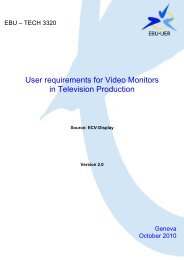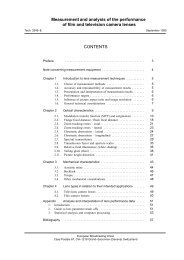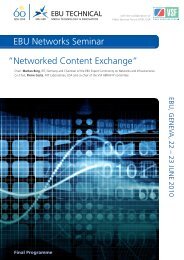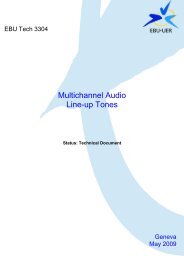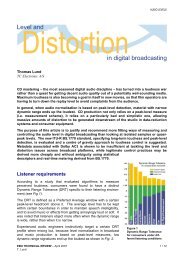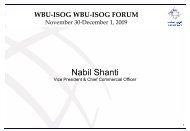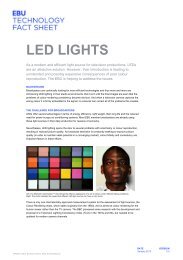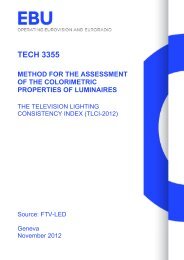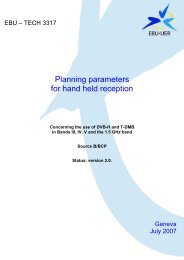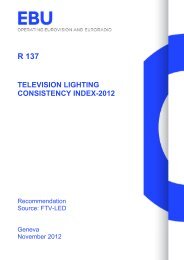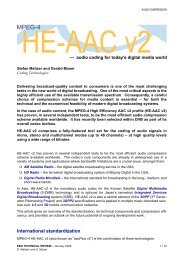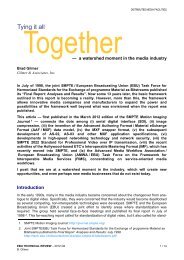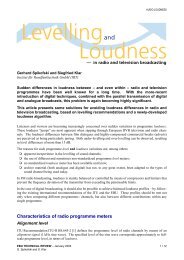Production Technology Seminar 2009 - EBU Technical
Production Technology Seminar 2009 - EBU Technical
Production Technology Seminar 2009 - EBU Technical
Create successful ePaper yourself
Turn your PDF publications into a flip-book with our unique Google optimized e-Paper software.
Some extreme examples [13]: movies with very low level of average loudness (e.g. -28 dBFS) and a big<br />
difference between the average loudness and the maximum peak level – and on the other hand<br />
commercials with very high average loudness level (e.g. -13 dBFS) and very small dynamic range. And<br />
we cannot transmit audio unaltered with this 15 dB difference - that would be unacceptable for listeners.<br />
What did we do up to now? We normalized to the peaks with PPM (Peak Programme Meter) [14] (to<br />
'quasi-peaks', taking into account the 10 ms reaction time meters), making the situation of average<br />
loudness even worse with an even larger difference between movies and commercials! So to broadcast<br />
it, we compress the audio signal [15]. We still have the same peaks, but we push up the low-level details.<br />
Of course we sacrifice the dynamic range. So, this solution is already a compromise.<br />
The ideal solution would be to normalise to loudness instead of peaks [16]. The -31 dB figure in the<br />
"Line mode" stems from the Dolby system (it is the lowest possible value of their loudness metadata<br />
parameter 'DIALNORM'). Everything, from the line level signal to the decoder of the set-top box, is<br />
aligned to the same -31 dBFS level, loudness normalised, and we have a totally varying peak value with<br />
the constant loudness value. That would already be a fantastic solution, the consumer at home not being<br />
forced anymore to adjust the volume with his/her remote control. An interesting area is this huge amount<br />
of headroom for the programmes that used to be highly compressed, especially the commercials that<br />
could be produced again in a transparent dynamic way. Compression would only be used for artistic<br />
reasons and not for the only purpose of sounding louder and louder! A problem might be that the<br />
dynamic range may be too big for the living room.<br />
But we live in a non-homogeneous coding world (PCM, Dolby, MPEG…). If we switch to a channel with<br />
MPEG-1 Audio Layer II, usually the loudness is in the range of –20 dB [17], and so there is a gap of<br />
11 dB between programmes normalised at -31 dB loudness and programmes transmitted as they are.<br />
Therefore there is a second mode in the system called "RF mode" normalising the loudness to -20 dB,<br />
more comparable to the legacy MPEG Audio programmes found in other channels. We have again<br />
loudness normalisation, but we have nevertheless to apply some compression to avoid overshooting, for<br />
the action movies, for example.<br />
Therefore we are looking at the Recommendation developed by the ITU Working group 6G,<br />
normalising everything to -23 dB, suggesting a new maximum true peak level of -2 dB [18].The ultimate<br />
goal is that the ITU Rec. will be the same as the <strong>EBU</strong> Rec.<br />
Another recommendation from the Utrecht school of Music <strong>Technology</strong> [19] suggests -21 dB as the<br />
target level (but it is only 2 dB apart ITU Rec., even less in fact) and a maximum peak level of -5 dB, the<br />
reason for this value being the concern for the analog re-broadcasters.<br />
As far as measurement is concerned the ITU Group issued Recommendation BS.1770, which is now<br />
the basis for the implementation of most loudness meters. It is a very simple measurement, easy to<br />
implement. Starting from the well-known weighting curves [21]: A (very low level signals) … D (for noise<br />
measurement). The revised low-frequency B-curve is a very easy to implement high pass filter, and the<br />
B-curve has been modified for surround sound to include a high-frequency weighting filter [22], and this<br />
is the basis for the ITU measurement. This 2 nd Revised Low Frequency B-curve is named R2LB, or Kweighting.<br />
If you measure Loudness, you then speak of LKFS (Loudness, K-Weighting and Full Scale),<br />
for example "-23 LKFS" (no need to say "dB LKFS"…), and if you substitute R2LB to K it becomes<br />
LR2LBFS [26]!<br />
One of the issue is on which signal type do we base our measurement? There are strong contenders<br />
for voice (Dolby) but there are others for music (concerts), sound effects (commercials - there are very<br />
short pieces where an algorithm for detecting dialog and speech has not enough time). The ultimate goal<br />
is to find a basis as broad as possible, and we certainly will recognise and recommend all three types of<br />
signals [28].<br />
Gating is also very important. For example, during a golf sport transmission, nothing is happening in<br />
audio for a long time (very little atmosphere, presenter saying something, then half a minute silence…).<br />
You don't want the measurement to be just too low because most of your transmission is very low level.<br />
So we are thinking about a threshold level below which the measurement is paused. This must be the<br />
© <strong>EBU</strong> <strong>2009</strong> / <strong>Production</strong> <strong>Technology</strong> seminar / January 27 - 29, <strong>2009</strong><br />
Reproduction prohibited without written permission of <strong>EBU</strong> TECHNICAL & <strong>EBU</strong> TRAINING<br />
15



